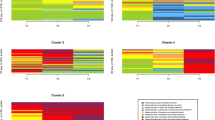Abstract
Evaluated an intervention package for increasing requesting opportunities in special education classrooms. Five teachers, serving 26 children with moderate to severe disabilities, received in-service training, consultation, and feedback on the use of three strategies designed to create opportunities for requesting (i.e., missing item, interrupted chain, delayed assistance). Observations were conducted in a multiple-baseline across classrooms design to record the number and types of opportunities provided by each teacher. During baseline, few opportunities for requesting were observed. The number of opportunities for requesting and the number of correct student responses increased during intervention. Opportunities continued to be provided during generalization and follow-up sessions. The study demonstrated an effective strategy for helping teachers incorporate opportunities for functional communication into the natural environment.
Similar content being viewed by others
References
American Psychiatric Association. (1987).Diagnostic and statistical manual of mental disorders (3rd ed. rev.). Washington, DC: Author.
Carr, E. G. (1982). Sign language. In R. Koegel, A. Rincover, & A. Egel (Eds.),Educating and understanding autistic children (pp. 142–157). San Diego: College Hill.
Cipani, E. (1988). The missing item format.Teaching Exceptional Children, 21, 25–27.
Cipani, E. (1989). Providing language consultation in the natural context: A model for delivery of services.Mental Retardation, 27, 317–324.
Duker, P. C., & Moonen, X. M. (1986). The effect of two procedures on spontaneous signing with Down's syndrome children.Journal of Mental Deficiency Research, 30, 355–364.
Goetz, L., Gee, K., & Sailor, W. (1985). Using a behavior chain interruption strategy to teach communication skills to students with severe disabilities.Journal of the Association for Persons with Severe Handicaps, 10, 21–30.
Grossman, H. J. (1983).Classification in mental retardation. Washington, DC: American Association on Mental Deficiency.
Guess, D., Sailor, W., & Baer, D. M. (1974). To teach language to retarded children. In R. L. Schiefelbusch & L. Lloyd (Eds.),Language perspectives: Acquisition, retardation, and intervention (pp. 529–563). Baltimore: University Park Press.
Hall, G., & Sundberg, M. L. (1987). Teaching mands by manipulating conditioned establishing operations.Analysis of Verbal Behavior, 5, 41–53.
Halle, J. W. (1987). Teaching language in the natural environment: An analysis of spontancity.Journal of the Association for Persons with Severe Handicaps, 12, 28–37.
Halle, J. W. (1988). Adopting the natural environment as the context of training. In S. N. Calculator & J. L. Bedrosian (Eds.),Communication assessment and intervention for adults with mental retardation (pp. 155–185). Boston: Little, Brown.
Haring, T. G., Neetz, J. A., Lovinger, L., Peck, C., & Semmel, M. I. (1987). Effects of four modified incidental teaching procedures to create opportunities for communication.Journal of the Association for Persons with Severe Handicaps, 12, 218–226.
Harris, S. L. (1975). Teaching language to nonverbal children with emphasis on problems of generalization.Psychological Bulletin, 82, 565–580.
Hart, B., & Risley, T. F. (1975). Incidental teaching of language in the preschool.Journal of Applied Behavior Analysis, 8, 411–420.
Horner, R. D., & Baer, D. M. (1978). Multiple-probe technique: A variation of the multiple-baseline.Journal of Applied Behavior Analysis, 11, 189–196.
Hunt, P., Goetz, L., Alwell, M., & Sailor, W. (1986). Using an interrupted behavior chain strategy to teach generalized communication responses.Journal of the Association for Persons with Severe Handicaps, 11, 196–204.
Lovaas, O. I., Koegel, R., Simmons, J. Q., & Long, J. S. (1973). Some generalization and follow-up measures on autistic children in behavior therapy.Journal of Applied Behavior Analysis, 6, 131–166.
Peck, C. A., Killen, C. C., & Baumgart, D. (1989). Increasing implementation of special education instruction in mainstream preschools: Direct and generalized effects of nondirective consultation.Journal of Applied Behavior Analysis, 22, 197–210.
Reichle, J., Anderson, H., & Schermer, G. (1986).Establishing the discrimination between requesting objects, requesting assistance and “helping yourself.” Unpublished manuscript, University of Minnesota, Minneapolis.
Sailor, W., & Mix, B. (1975).The Topeka Association for Retarded Citizen's Assessment System. Austin, TX: Pro-ed.
Sigafoos, J., Doss, S., & Reichle, J. (1989). Developing mand and tact repertoires in persons with severe developmental disabilities using graphic symbols.Research in Developmental Disabilities, 10, 183–200.
Sigafoos, J., Roberts, D., Kerr, M., Couzens, D., & Baglioni, T. (1994). Opportunities for communication in classrooms serving children with developmental disabilities.Journal of Autism and Developmental Disorders, 24, 259–279.
Sosne, J. B., Handleman, J. S., & Harris, S. L. (1979). Teaching spontaneous-functional speech to autistic type children.Mental Retardation, 17, 241–245.
Spradlin, J. E., & Siegel, G. M. (1982). Language training in natural and clinical environments.Journal of Speech and Hearing Disorders, 47, 2–6.
Stokes, T. F., & Baer, D. M. (1977). An implicit technology of generalization.Journal of Applied Behavior Analysis, 10, 349–367.
Tirapelle, L., & Cipani, E. (1992). Developing functional requesting: Acquisition, durability, and generalization of effects.Exceptional Children, 58, 260–269.
Warren, S. F., Rogers-Warren, A. K., Baer, D. M., & Guess, D. (1980). Assessment and facilitation of language generalization. In W. Sailor, B. Wilcox, & L. Brown (Eds.),Methods of instruction for severely handicapped students (pp. 227–258). Baltimore: Paul H. Brookes.
Author information
Authors and Affiliations
Additional information
Preparation of this manuscript was supported in part by grant number NSRG-34-GOV 92 from The University of Queensland.
Rights and permissions
About this article
Cite this article
Sigafoos, J., Kerr, M., Roberts, D. et al. Increasing opportunities for requesting in classrooms serving children with developmental disabilities. J Autism Dev Disord 24, 631–645 (1994). https://doi.org/10.1007/BF02172143
Issue Date:
DOI: https://doi.org/10.1007/BF02172143



